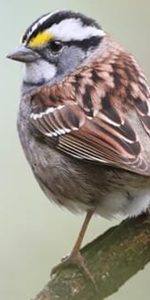| White-throated Sparrow | ||
 |
Classification(s) : | Prey |
| Cat Name : | Capped Sparrow | |
| Common Name : | White-throated Sparrow | |
| Scientific Name : | Zonotrichia albicollis | |
| Other Name(s) : | ||
| Physical Description : | The White-throated Sparrow is a rather large songbird with a bulbous beak. The full-bodied sparrow has a round head and long tail and legs. The body is brown on top and a pale gray below, and its bill is a light pewter gray. The most prominent features are its white throat and black and white striped head, and it has a bright yellow patch between the base of the bill and its eye. A less dominant version of this coloring would be the tan-striped variety, where instead of black and white stripes, there are mocha brown and beige stripes. |
|
| Physical Statistics : | Length – 6.3 – 7.1 Inches (16 – 18 Centimeters) |
|
| Behavior : | White-throated sparrows forage on the ground for seeds. When doing so, they usually stay in flocks. They come into the forests during the summer, and vanish after the breeding season. |
|
| Social Organization : | The White-throated Sparrow is almost always found in a flock. |
|
| Approval Level : | None; White-throated Sparrows are found almost everywhere from forests to fields to pond edges and even in parks and suburbs. | |
| Kill Difficulty : | ; The white-throated sparrow is practically defenseless, other than being able to take flight when fleeing from predators. |
|
| Training Level : | Specialty - Group Flying; These sparrows tend to stay in flocks, so some will have to be distracted or isolated before they are hunted. |
|
| Hunting Tactic : | Songbirds | |
| Food Quality : | Medium; While slightly small, they possess rich flesh that is rather tasty. | |
